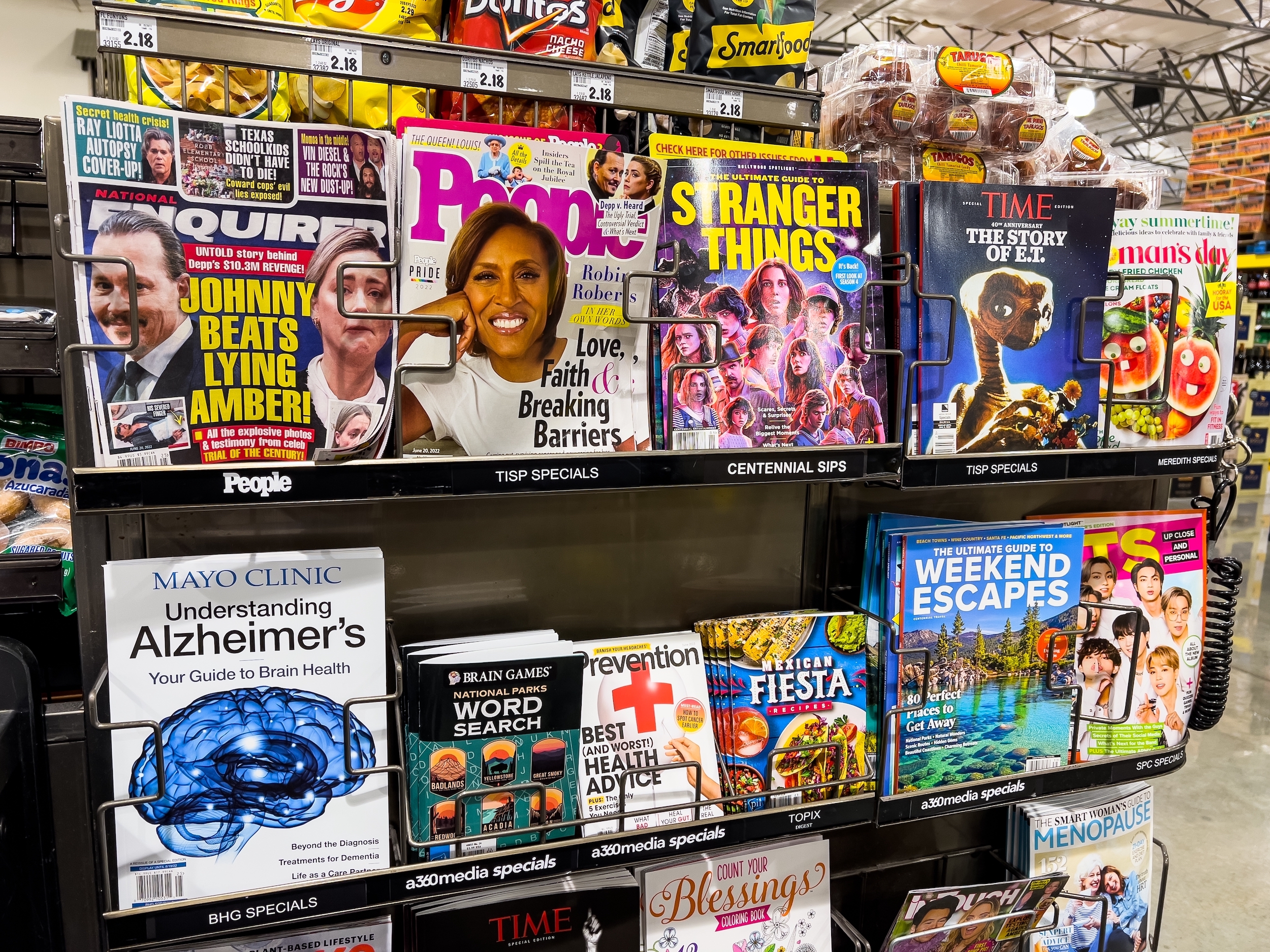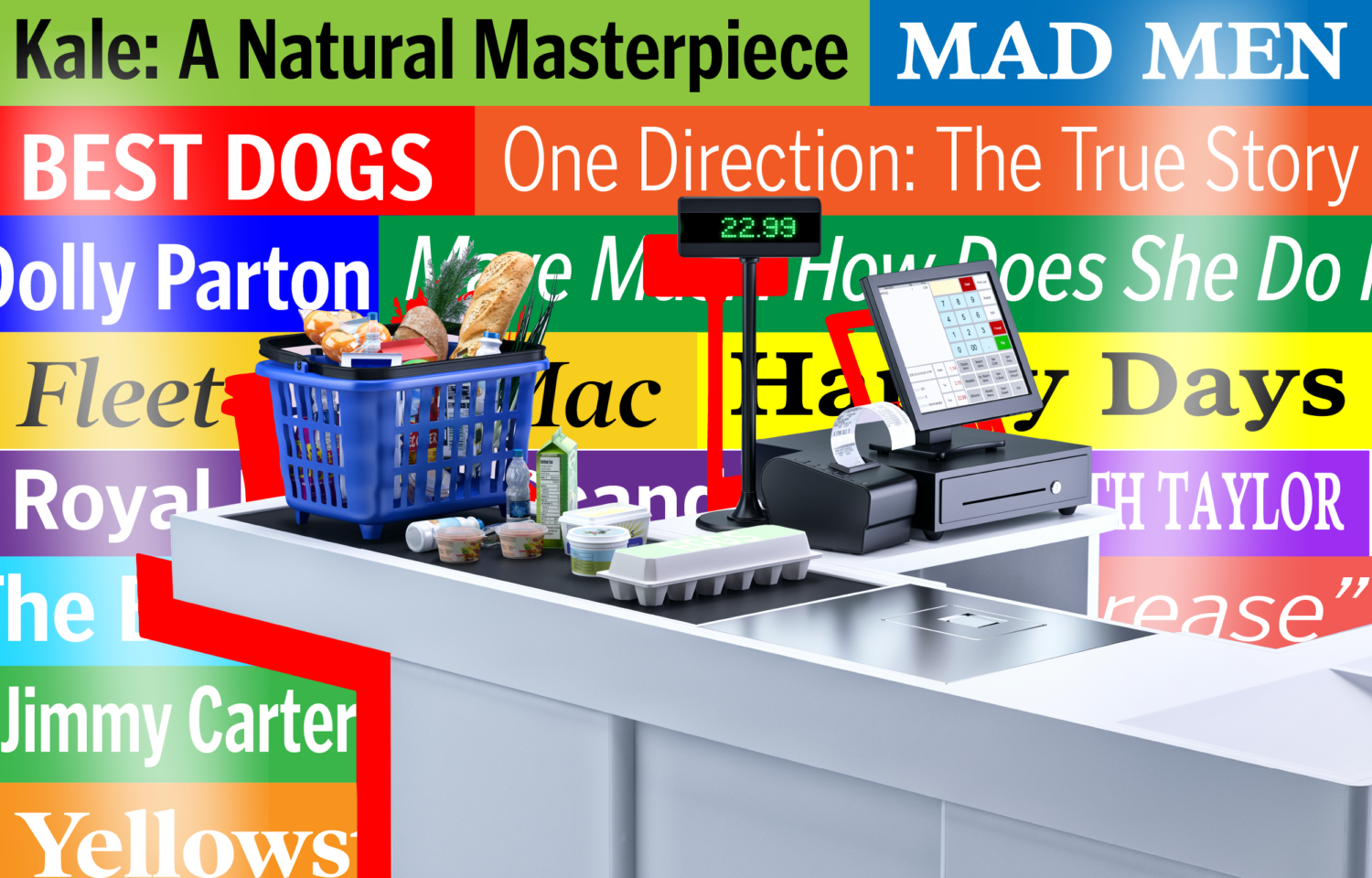Since their peak in the ’90s, print media companies have sought strategies and new publications that might save them from their financial woes.
The check-out line at the grocery store might seem the least likely place for that solution to arise.
Yet single-theme magazines like “The Complete Guide to It’s A Wonderful Life” or “Bob Saget: Tribute to America’s Dad,” part of a genre called special interest publications or bookazines, have become a surprising winner in the magazine media market.
The two biggest publishers of these magazines, Dotdash Meredith and a360media, control almost 60% of the marketplace based on revenue, according to Samir “Mr. Magazine” Husni, founder of the Magazine Innovation Center at the University of Mississippi’s School of Journalism and New Media and founder and director of the Magazine Media Center. In fact, says a spokesperson for a360media, special interest magazines are the only magazine segment to achieve growth in the last few years. Special interest publications grew 8% in 2020 and 20% in 2021, year over year, per the spokesperson. Magazines not in this category declined by 10 to 20% over the same period.
This growing investment in special interest publications shows how much the commercial strategy of the magazine industry has changed.
“It is completely the opposite of the business model of the 20th century for magazines,” Husni said. “We used to have the magazine almost for free, selling the customers to the advertisers, giving the content to the customers. Now we are in the business of selling the content to the customers.”
MORE FROM POYNTER: Where have all the magazines gone?
These magazines are broad in scope but not in theme. Issues generally offer a deep look at a single topic. One issue, a 100th birthday tribute to actress Doris Day, includes articles on the celebrity’s legacy, the start to her career and her work with filmmaker Alfred Hitchcock, among others. Another, which looks at the life of a dog, talks about alternative medicine for pups, how to protect them against household hazards and the bond between human and canine. The central topic of an issue always remains the same.
Prices also set these magazines apart. The average special interest magazine might go for between $13 and $14, according to Husni, in contrast to more traditional magazines, which generally cost less than $10.
“You’re no longer talking about an impulse buy,” he said. “You are talking about a curated, creative product.”
And it’s that very service that the audience is paying for, he said. Readers don’t want to spend hours perusing the internet for a specific question on their favorite topic when they can buy a magazine that functions as a curated keepsake with all the answers.
These magazines aren’t new. In the 1970s through 1990s, Hearst Magazines and the former Meredith Corp. used these publications to test the market. They would put out an issue of something highly specific, like Better Homes and Gardens or Country Living, to see if it would stick. If the first one didn’t do well, they would attribute it to lack of interest and not print another, Husni said. But if a title did well, it had the potential — like Better Homes and Gardens and Country Living — to take on a life of its own.
Companies like a360media still take that strategy with special interest publications. They give them two issues to perform, Husni said. But there is a key difference — these magazines are meant to be sold only in retail contexts rather than to subscribers. That means that almost everything hinges on the price, since special interest publications rarely have advertisements.
And at $13 or $14, where is the price ceiling? Husni asks. It’s a question he also posed to Doug Olson, president and chief media officer of a360media, in an October 2022 interview on his Mr. Magazine website.
“We’re getting in the territory where it’s going to be hard to justify many more price increases, unless something from the trim size or amount of content also increases,” Olson said at the time. “… But I also would have answered the question the same way five years ago when we were at about $10 and didn’t see $14 or $15 as being a reachable price, but we’ve obviously proven that wrong.”
How do they work?

Magazines and tabloids for sale at a supermarket in Sacramento, Calif., on July 28, 2022. (Shutterstock)
Olson prefers to call these magazines “bookazines,” according to his interview with Husni. That, he says, better reflects the essence of what they are.
“I know a lot of people call them specials, but it’s really people who are into enthusiast-type topics,” Olson said. “… I really think this is the part of the magazine business that is definitely the future of magazines — smaller, passionate groups around something that they have a high interest in that they’re willing to pay for.”
A360media is putting money into that prediction. It acquired two special interest publishers, Centennial Media and Bauer USA, in 2022. Centennial Media ranked within the top 10 U.S. publishers based on retail sales, per reporting from Flashes and Flames. Bauer published more than 100 special interest publications per year, including Woman’s World and First for Women.
“The addition of Woman’s World and First for Women will have an immediate impact on our newsstand business while the bookazine business and the incredible upside these powerful brands bring to our digital capabilities set us up for continued growth in both audience and revenues,” said Olson in a press release.
A360media shows no signs of stopping. A spokesperson noted its continued confidence in special interest publications.
“We know that today’s consumer is passionate and invested in their individual lifestyles and preferences and believe that SIPs provide an excellent product experience that provides education, enjoyment and satisfies curiosity,” wrote Diego Romero, the a360media spokesperson. “SIP products account for a growing portion of a360media’s retail sales, supporting our bullish interest in the evolving SIP market.”
Olson echoed that attitude in his October interview with Husni.
“I’m very optimistic about magazines,” he said. “The part of the magazine business that has grown, up until the headwinds everybody faced in 2022, has really been the specials and bookazines part of the business.”
These positive sentiments run counter to the reality at Centennial. Last month, most of the organization’s full-time staffers were laid off, according to multiple freelancers familiar with the issue and confirmed by Romero. An email to staff from a former editor noted that “a360 is making changes and the SIPS will now be outsourced.” Freelance staff and “impacted employees” were “encouraged” to “proactively pursue future work with our various content partners,” according to Romero.
“The a360media business model involves engaging trusted third party content providers to help develop our SIPs, which allows us to work with true subject matter experts on each and every publication that we produce,” Romero said in an email. “As part of our integration efforts, we have made the decision to evolve the Centennial business model, which relied upon an internal edit team, to be aligned with that of a360media.”
To be a journalist there …

Magazines and tabloids for sale at a supermarket in Sacramento, Calif., on July 28, 2022. (Shutterstock)
Special interest publications have also been a fruitful source of income for freelance journalists. The magazines are often managed by freelancers rather than full-time staffers. Joanna Powell, a frequent freelancer for Centennial, has served as the editor-in-chief for various themed issues.
Powell called Centennial “a lifeline for journalists,” although that is now in question with its transition to new ownership. A longtime journalist, she took a buyout from People Magazine in 2007 and planned to come back to the profession after a little time off. She quickly realized that there was no “there” to which she could come back.
Instead, she started freelancing, primarily for Bauer, one of the two SIP companies a360media bought in 2022. The bulk of her work now is for Centennial, where she spends six weeks to two months editing each issue. When she’s on assignment, it’s more than a full-time job, but over a year’s time, it evens out to half-time hours.
Freelance writer Katherine Cullen had a similar entrance to special interest publications. Her first job was as an editor with Psychology Today. But in 2015, she decided to work directly in the mental health sphere.
For a while, she loved the work at Centennial. She wrote one to four articles every few months on topics like health and psychology. The topics ran the gamut — her favorite was a piece on the physiology and mechanics of a fart. The deadlines were reasonable, and the pay — at roughly 50 cents a word — was around where she wanted it to be.
But last summer, Cullen noticed something was wrong. On July 29, she’d invoiced for an $800 piece. Two months went by and she noticed that she had still not been paid. Past payments had come in no more than a month. Her editor had also noticed the payment discrepancy. That was when Cullen learned that it was not an individual issue but likely freelancer-wide, and that a group of freelancers had already decided to involve the National Writers Union.
Over the last few years, the union has “developed a reputation,” NWU president Larry Goldbetter said, for getting payments for freelancers. But when he first heard from a freelancer, his first question was not, “How did this happen?,” but “What is this?”
“I was not familiar with Centennial at all and the grievance officer who we passed it onto wasn’t familiar with them,” he said. “We’ve had grievances against magazines, but this type of thing is at the checkout line in K-Mart or the airport — that was a new experience.”
By the time NWU got involved, the freelancers alleging missed payments had risen to at least 40 people, Goldbetter said. Around that time, the purchase of Centennial by a360media became clear. Before NWU could do anything concrete, the payments finally came through, although Goldbetter says they likely “heard through the grapevine” that the union “was involved.”
Once Cullen was paid, a silver lining remained: the group email chain with editors and freelancers that emerged from the initial complaint. In freelancing, an industry whose workers generally spend most of their time seated alone at a desk, it’s not always easy to make connections.
“I got to connect with so many people and they are dropping leads for other assignments and work opportunities as we speak,” Cullen said. “We’re opining on the injustices of print going away and it’s been a nice place to vent and just feel validated.”
What does the future hold?
It’s clear that special interest publications are here to stay — at least until the next big strategy comes along. Dotdash Meredith is already testing a subscription to six issues of special interest publications, although the specific themes will be a surprise to the recipient, Husni said.
Husni sees the future of newsstands as becoming more about bookazines and less about weeklies and mainstream magazines. He attributes that largely to revenue.
Still, Olson noted in his interview with Husni that the future is not all bright. He worries that rising costs thanks to inflation might lower the disposable income available to readers of special interest magazines. Will they want to spend $13 or $14 an issue when they’re already spending more at the grocery store or at the gas tank?
Husni comes at it from a more philosophical view: Look at what special interest publications actually offer readers. It’s different than the standard magazine, but that doesn’t mean it’s not hard work.
“There is still a lot of creative curation taking place in print and a lot of people ignore that,” he said. “It’s much harder to take a topic like The Beatles or Meghan and Harry and distill it to 90 pages and have enough content in it that you are willing to pay the 14 or 15 dollars.”







